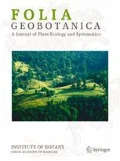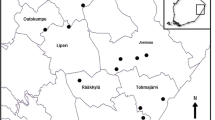Abstract
Bryophytes form one-layered communities, which provide good opportunities to test predictions of the species pool hypothesis. The prediction that competitive exclusion occurs rarely, if at all, in established communities seems to hold for many types of bryophyte vegetation, but the drastic effects on local diversity of some invading exotic species suggests, that this may be partly due to the “ghost of competition past”. In a survey of bryophyte communities on earth banks, variation in species number per stand was rather larger than predicted by the species-pool hypothesis. Large differences in accessibility of the stands may have played an important role in this respect.
Small-scale repeated chartings and permanent grid studies suggest, that competitive exclusion hardly ever occurs in a range of terrestrial bryophyte communities. Evidence for interspecific competition (as derived from small-scale association between behaviour — increase or decrease in grid cells — of species pairs) was equally rare, but this may have been due to interaction with positively density-dependent facilitation effects. However, a rigorous proof of the hypothesis that facilitation may prevent competitive exclusion is still lacking.
Similar content being viewed by others
References
Bates J.W. (1988): The effect of shoot spacing on the growth and branch development of the mossRhytidiadelphus triquetrus.New Phytol. 109: 499–504.
Benzing D.H. (1981): Bark surfaces and the origin and maintenance of diversity among angiosperm epiphytes: a hypothesis.Selbyana 5: 248–255.
Biermann R. &Daniels F.J.A. (1997): Changes in a lichen-rich dry sand grassland vegetation with special reference to lichen synusiae andCampylopus introflexus.Phytocoenologia 27: 257–273.
Callaway R.M. &Walker L.R. (1997): Competition and facilitation: a synthetic approach to interactions in plant communities.Ecology 78: 1958–1965.
Connell J.H. (1980): Diversity and the coevolution of competitors, or the ghost of competition past.Oikos 35: 131–138.
During H.J. (1990): Clonal growth patterns among bryophytes. In:van Groenendael J. &de Kroon H. (eds.),Clonal growth in plants, SPB Academic Publishing, The Hague, pp. 163–176.
During H.J. &Lloret F. (1996): Permanent grid studies in bryophyte communities I. Pattern an dynamics of individual species.J. Hattori Bot. Lab. 79: 1–41.
During H.J. &ter Horst B. (1987): Diversity and dynamics in bryophyte communities on earth banks in a Dutch forest.Symp. Biol. Hung. 35: 447–455.
During H.J. &van Tooren B.F. (1988): Pattern and dynamics in the bryophyte layer of a chalk grassland. In:During H.J., Werger M.J.A. &Willems J.H. (eds.),Diversity and pattern in plant communities, SPB Academic Publishing, The Hague, pp. 195–208.
Eriksson O. (1993): The species-pool hypothesis and plant community diversity.Oikos 68: 371–374.
Hacker S.D. &Gaines S.D. (1997): Some implications of direct positive interactions for community species diversity.Ecology 78: 1990–2003.
Herben T. (1987): The ecology of the invasion ofOrthodonitum lineareSchwaerg. in Central Europe.Symp. Biol. Hung. 35: 323–333.
Hubbell S.P. (1979): Three dispersion, abundance, and diversity in a tropical dry forest.Science 203: 1299–1309.
Huisman J. &Weissing F.J. (1999): Biodiversity of plankton by species oscillations and chaos.Nature 402: 407–410.
Kikvidze Z. &Nakhutsrishvili G. (1998): Facilitation in subnival vegetation patches.J. Veg. Sci. 9: 261–264.
Kull K. &Zobel M. (1991): High species richness in an Estonian wooded meadow.J. Veg. Sci. 2: 711–714.
Lippmaa T. (1939): The unistratal concept of plant communities (the unions).Amer. Midl. Naturalist 21: 111–145.
Lloret F. (1994): Gap colonization by mosses on a forest floor: an experimental approach.Lindbergia 19: 122–128.
Økland R.H. (1990): Vegetation ecology: theory, methods and applications with reference to Fennoscandia.Sommerfeltia Suppl. 1: 1–233.
Økland R.H. (2000): Population biology of the clonal mossHylocomium splendens in Norwegian boreal spruce forests. 5. Consequences of the vertical position of individual shoot segments.Oikos 88: 449–469.
Økland R.H. &Økland T. (1996): Population biology of the clonal mossHylocomium splendens in Norwegian boreal spruce forests. II. Effects of density.J. Ecol. 84: 63–69.
Roxburgh S.H. &Chesson P. (1998): A new method for detecting species associations with spatially autocorrelated data.Ecology 79: 2180–2192.
Rydin H. (1997): Competition among bryophytes.Advances Bryol. 6: 135–168.
Rydin H. &Barber K.E. (2001): Long-term and fine-scale coexistence of closely related species.Folia Geobot. 36: 53–61.
Rydgren K., Økland R.H. &Økland T. (1998): Population biology of the clonal mossHylocomium splendens in Norwegian boreal spruce forests. 4. Effects of experimental fine-scale disturbance.Oikos 82: 5–19.
Schotsman N. &During H.J. (1977): Houtwallen in Friesland: oecologie en beheer (Wooded banks in Friesland: ecology and management).Ned. Boschbouw-Tijdschr. 49: 320–326.
Siebel H.N. &van Dort K.W. (1999): Mossengemeenschappen in de plantensociologie (Moss communities in plant sociology).Stratiotes 19: 37–49.
Slack N.G. (1997): Niche theory and practice: Bryophyte studies.Advances Bryol. 6: 169–204.
Sokal R.R. &Rohlf F.J. (1995):Biometry. Ed. 3, Freeman & Company, New York.
Terborgh J., Foster R.B. &Nunez V.P. (1996): Tropical tree communities: a test of the nonequilibrium hypothesis.Ecology 77: 561–567.
van der Hoeven E.C. (1999):Do chalk grassland bryophytes compete? PhD. Thesis, Utrecht University, Utrecht.
van der Hoeven E.C. &During H.J. (1997): The effect of density on size frequency distributions in chalk grassland bryophyte populations.Oikos 80: 533–539.
van der Maarel E. &Sykes M.T. (1993): Small-scale plant species turnover in a limestone grassland: the carousel model and some comments on the niche concept.J. Veg. Sci. 4: 179–188.
van der Meulen F., van der Hagen H. &Kruijsen B. (1987):Campylopus introflexus. Invasion of a moss in Dutch coastal dunes.Proc. Kon. Ned. Akad. Wetensch. 90: 73–80.
van Tooren B.F. &During H.J. (1988): Early succession of bryophyte communities on Dutch forest earth banks.Lindbergia 14: 40–46.
van Tooren B.F., van Dam D. &During H.J. (1990): The relative importance of precipitation and soil as sources of nutrients forCalliergonella cuspidata (Hedw.)Loeske in chalk grassland.Funct. Ecol. 4: 101–107.
Weeda E.J. (1987): Invasions of vascular plants and mosses into the Netherlands.Proc. Kon. Ned. Akad. Wetensch. 90: 19–29.
Zobel K. (2001): On the species-pool hypothesis and on the quasi-neutral concept of plant community diversity.Folia Geobot. 36: 3–8.
Author information
Authors and Affiliations
Corresponding author
Rights and permissions
About this article
Cite this article
During, H.J., Lloret, F. The species-pool hypothesis from a bryological perspective. Folia Geobot 36, 63–70 (2001). https://doi.org/10.1007/BF02803139
Issue Date:
DOI: https://doi.org/10.1007/BF02803139




